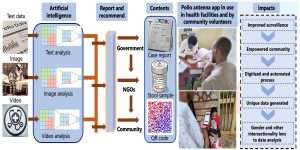Polio Antenna: AI-powered AFP surveillance system
Acute flaccid paralysis (AFP) surveillance is the heart of polio eradication efforts. Existing AFP surveillance system is paper-based, requires surveillance officers to go in-person to do surveillance, home visits by community key informants, and sharing information on papers, through phone calls, and social media messaging apps. However, current AFP surveillance system faces two major challenges. The first challenge is that not all paralysis is AFP. Secondly, current surveillance system is still low in quality and not sensitive enough due to low coverage, delays, underutilization of surveillance data, staff turnover, lack of refresher trainings, pandemics, and other issues.
To overcome this issue, we developed a fully automated system powered by artificial intelligence (AI) that’s used by government, communities, and non-governmental organizations (NGOs). When a registered user suspects AFP case, the user opens the app, enter information requested on the app, take a picture, record a short video, and upload it. The app analyzes the data entered and instantly report it to all the stakeholders, including vicinity health officer, designated surveillance worker, Ethiopian Public Health Institute (EPHI) officer, Ministry of Health (MoH) officer, NGOs, and WHO officer, see Fig. 1. At the same time, the app recommends the user what to do to contain and monitor the case. Moreover, the app tracks stool sample taken using QR technology that holds all the information about the suspected case, automating stool transportation and tracking. The surveillance data is visualized on the dashboard of the repository developed for this system. The repository is unique in its nature capturing AFP surveillance data, not only in text form but also in image and video formats automating decision making and enabling AI models to be trained on.

Summary of the developed AI-powered AFP surveillance system.
The app works in three languages, including English, Amharic, and Afaan Oromoo. The app is being used for a test in Oromia region, Jimma Zone by government and communities. This has significant impact in revolutionizing AFP surveillance. First, it improves AFP surveillance performance decreasing case reporting time by 45%, increasing sensitivity by 40%, reducing cost by 80%, and increasing surveillance coverage by 50%. Second, it empowers communities by enabling them carry out AFP surveillance on their own and by making them part of outbreak response, ultimately empowering them to safeguard their health. Third, the developed system automates and digitizes AFP surveillance as it uses a paperless model, abolishes in-person visit model, and overcomes stool sample mixing using QR code. Fourth, the current AFP case reporting does not consider gender and other intersectionality in its data analysis. The developed surveillance system has data analysis capability with gender and other intersectionality cases considered. Fifth, the data generated using this system and the repository developed plays a significant role in educating the public, enhancing research, improving AI model training, and informing policies.
Research Projects |
